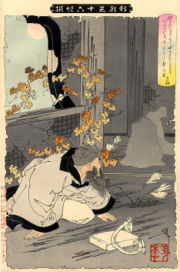
Sogi
Encyclopedia

Japanese people
The are an ethnic group originating in the Japanese archipelago and are the predominant ethnic group of Japan. Worldwide, approximately 130 million people are of Japanese descent; of these, approximately 127 million are residents of Japan. People of Japanese ancestry who live in other countries...
poet
Poet
A poet is a person who writes poetry. A poet's work can be literal, meaning that his work is derived from a specific event, or metaphorical, meaning that his work can take on many meanings and forms. Poets have existed since antiquity, in nearly all languages, and have produced works that vary...
. He came from a humble family from the province of Kii
Kii Province
, or , was a province of Japan in the part of Honshū that is today Wakayama Prefecture, as well as the southern part of Mie Prefecture. Kii bordered Ise, Izumi, Kawachi, Shima, and Yamato Provinces. The Kii Peninsula takes its name from this province....
or Ōmi
Omi Province
is an old province of Japan, which today comprises Shiga Prefecture. It was one of the provinces that made up the Tōsandō circuit. It is nicknamed as .Lake Biwa, Japan's largest lake, is located at the center of the province...
, and died in Hakone
Hakone, Kanagawa
is a town in Ashigarashimo District in Kanagawa Prefecture, Japan. As of 2010, the town had an estimated population of 13,339 and a density of 144 persons per km². The total area was 92.82 km².-Geography:...
on September 1, 1502. Sōgi was a Zen monk from the Shokokuji temple in Kyoto
Kyoto
is a city in the central part of the island of Honshū, Japan. It has a population close to 1.5 million. Formerly the imperial capital of Japan, it is now the capital of Kyoto Prefecture, as well as a major part of the Osaka-Kobe-Kyoto metropolitan area.-History:...
and he studied poetry, both waka
Waka (poetry)
Waka or Yamato uta is a genre of classical Japanese verse and one of the major genres of Japanese literature...
and renga
Renga
' is a genre of Japanese collaborative poetry. A renga consists of at least two or stanzas, usually many more. The opening stanza of the renga, called the , became the basis for the modern haiku form of poetry....
. In his 30's he became a professional renga poet.
During his travels to almost every corner of Japan, he was welcomed by the most powerful political, military and literary figures of his day. He attracted more disciples than any other poet of his generation. After traveling throughout Japan, he returned to Kyoto where he commanded great respect.
He is best-remembered for his renga, wherein two or more poets collaborate to create a poem, by writing alternate stanzas. In Sōgi's day, such renga were typically 100 verses in length. Arising from the court tradition of waka, renga was cultivated by the warrior class as well as by courtiers, and some of the best renga poets, such as Sōgi, were commoners.
Sōgi is considered the greatest master of renga, his two most famous works being "Three Poets at Minase" (Minase sangin hyakuin, 1488) and "Three Poets at Yuyama" (Yuyama sangin hyakuin, 1491). This outstanding poet left more than 90 works (anthologies, diaries, poetic criticisms and manuals, among others). Before his death, he wrote "Sōgi Alone", which mostly includes his memoirs.

